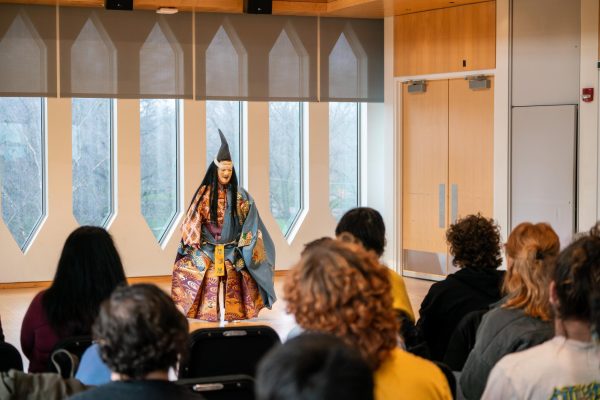Nintendo Releases “Animal Crossing” Game for Mobile
Animal Crossing: Pocket Camp is the latest in Nintendo’s Animal Crossing games — but instead of being for the Nintendo DS, it’s a mobile phone app. It has many similar features to previous games, such as character customization, fishing, and bug catching, but also adds in new elements. The game blends old and new so seamlessly that those who have never played the game before will get just as much enjoyment as those who have been playing the games since Wild World came out.
Animal Crossing: Pocket Camp tasks your character with creating a campground by using resources you’ve received for helping out local animals. There are different campground themes available such as cute, natural, cool, and sporty, and the animal that you first interact with varies depending on the theme. Other than this first interaction, the initial theme seems to be fairly unimportant given that, throughout the game, amenities not directly correlating to your theme can also be crafted.
Unlike Nintendo’s two game system versions, the Pocket Camp map is made up of islands, each of which has specific resources that can only be found there. Although I enjoy the open play of the handheld systems, I understand why Nintendo had to divvy up the resources between islands to create scarcity so that players would interact with each other. Similarly, the animals that you can interact with are not permanent residents of their areas but rotate out every couple of hours to simulate them “camping” there. It can make increasing friendship with specific animals challenging, but Nintendo provided a solution with Calling Cards, which allow you to call a specific animal to an area. Each animal has three requests per visit, in which you provide them with bugs, fish, fruit, or shells in return for Bells (the in-game currency), crafting materials, essences, and friendship points.
Get enough points to achieve the next level of friendship, and a player’s character receives experience points that go toward level increases. Higher friendship levels also allow players to invite animals to their campsite, provided they have the proper amenities and furniture. Different animals require different furniture to be present at the campsite before they can visit, but you may remove the furniture once the animal is established at your campsite. This was an important feature to include because, while it is annoying to craft individual pieces of furniture for each animal, at least it won’t mess up how you want your campsite to look. In my game I focus on crafting what I want to craft and designing my campsite instead of adding more animals to my campsite, even though inviting animals to your campsite does help you keep track of them and it also lets you increase their friendship level.
Crafting materials are used to make different types of furniture and with each level more ways to customize your campsite become available. This is an engaging feature, though it can be frustrating since there are different crafting times depending on the furniture and there is only one crafting slot available. Since players also receive essences from animals to upgrade or purchase new amenities, each animal has a specific theme that they will give you essences for. If you purchase or upgrade an amenity that correlates, your friendship with them will increase several levels. Receiving essences from animals can create an essence shortage if most of the visiting animals are of one theme. Therefore, it can take some time to collect enough essences to upgrade amenities — forcing players to ultimately farm for resources.
The app also allows fellow players to connect with each other. In the era of handheld games, players had to get friend codes, open gates, and connect to the internet to play with others. In the mobile game, it’s much easier. As most mobile devices are always connected, it is much faster to interact with other players and you don’t necessarily need a friend code to become someone’s friend. It feels weird to accept friend requests from random players, yet the more friends you have in the game, the more resources are available. Interactions with other players consist of visiting their campsite, giving kudos — akin to “liking” their campsite — and viewing their market box. This last aspect is the feature that most promotes communication and cooperation between players, as it allows the player to place items up for auction if they have too many of one item or their bag is full. This forces players to visit others’ campsites, making it more likely for them to give kudos as well as make more friends on the app. This becomes tedious, however, since you can view another player’s market box even without traveling to their campsite. Still, Nintendo made returning to your last location easy with a simple icon that allows users to go back without reopening the map.
Nintendo took further advantage of mobile games’ social aspect through a mining area that has rotating rewards and requires 20 leaf tickets — which are received as you level up, but can also be purchased for real money. You can also get into the mining area with the help of five friends. Only once you pay 20 leaf tickets or get five friends to help, you can visit the mine and get the reward. Getting five friends to help out can be difficult, and because leaf tickets cost real money it’s a way to get ahead in the game through in-app purchases. It would be preferable to the gameplay if Nintendo does not make leaf tickets so integral to gameplay that there is no way to enjoy or move forward in the game without purchasing them as many free-to-play games with in-app purchases do.
In terms of gameplay, Pocket Camp has all the addiction of the handheld Animal Crossing games with the convenience of a mobile phone platform. The graphics are on par with those you find in the handheld system, and it has plenty of customization without the hurdles. For example, hair color and style can be changed without needing to gain Shampoodles — the salon in the base games for changing hair color, eye color, and hairstyle — and customizing skin color is now an option as well. Previously, characters could get tan at most, and that only if they stood outside in the sun for prolonged stretches of time.
Pocket Camp is a lovely addition to the Animal Crossing franchise, with plenty of new mechanics to make it a standalone game, but lots of the familiar gameplay and themes that stay true to Animal Crossing’s roots.






